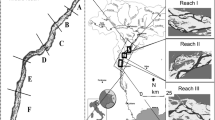Abstract
The usability of high-resolution satellite imagery for estimating spatial water quality patterns in urban water bodies is evaluated using turbidity in the lower Charles River, Boston as a case study. Water turbidity was surveyed using a boat-mounted optical sensor (YSI) at 5 m spatial resolution, resulting in about 4,000 data points. The ground data were collected coincidently with a satellite imagery acquisition (IKONOS), which consists of multispectral (R, G, B) reflectance at 1 m resolution. The original correlation between the raw ground and satellite data was poor (R 2 = 0.05). Ground data were processed by removing points affected by contamination (e.g., sensor encounters a particle floc), which were identified visually. Also, the ground data were corrected for the memory effect introduced by the sensor’s protective casing using an analytical model. Satellite data were processed to remove pixels affected by permanent non-water features (e.g., shoreline). In addition, water pixels within a certain buffer distance from permanent non-water features were removed due to contamination by the adjacency effect. To determine the appropriate buffer distance, a procedure that explicitly considers the distance of pixels to the permanent non-water features was applied. Two automatic methods for removing the effect of temporary non-water features (e.g., boats) were investigated, including (1) creating a water-only mask based on an unsupervised classification and (2) removing (filling) all local maxima in reflectance. After the various processing steps, the correlation between the ground and satellite data was significantly better (R 2 = 0.70). The correlation was applied to the satellite image to develop a map of turbidity in the lower Charles River, which reveals large-scale patterns in water clarity. However, the adjacency effect prevented the application of this method to near-shore areas, where high-resolution patterns were expected (e.g., outfall plumes).
Similar content being viewed by others
References
Baban, S. M. J. (1997). Environmental monitoring of estuaries; estimating and mapping various environmental indicators in Breydon Water Estuary, U. K., using Landsat TM imagery. Estuarine, Coastal and Shelf Science, 44, 589–598.
Blake, L. (2003). Lower Charles River Demonstration Project – Gunderboom® Beach Protection System™ – 2002. Lowell, MA: New England Interstate Water Pollution Control Commission (NEIWPCC).
Breault, R. F., Barlow, L. K., Reisig, K. D., & Parker, G. W. (2000). Spatial distribution, temporal variability, and chemistry of the salt wedge in the lower Charles River, Massachusetts, June 1998 to July 1999. U.S. Geological Survey Water-Resources Investigations Report 00-4124, 1 pl.
Breault, R. F., Sorenson, J. R., & Weiskel, P. K. (2002). Streamflow, water quality, and contaminant loads in the Lower Charles River Watershed, Massachusetts, 1999–2000. Water-Resources Investigations Report 02-4137, (p. 131)
Dekker, A. G., Vos, R. J., & Peters, S. W. M. (2001). Comparison of remote sensing data, model results and in situ data for total suspended matter (TSM) in the southern Frisian lakes. Science of the Total Environment, 268, 197–214.
Fraser, R. N. (1998). Multispectral remote sensing of turbidity among Nebraska Sand Hill lakes. International Journal of Remote Sensing, 23, 15–35.
Giardino, C., Pepe, M., Brivio, P. A., Ghezzi, P., & Zilioli, E. (2001). Detecting chlorophyll, Secchi disk depth and surface temperature in a sub-alpine lake using Landsat imagery. Science of the Total Environment, 268, 19–29.
Hellweger, F. L., Schlosser, P., Lall, U., & Weissel, J. K. (2004). Use of satellite imagery for water quality studies in New York Harbor. Estuarine, Coastal and Shelf Science, 61, 437–448.
Howman, A., Grobler, D., Kempster, P., & Seed, A. (1989). Landsat and limnologically derived water quality data: A perspective. Environmental Monitoring and Assessment, 13, 1–9.
Khorram, S., & Cheshire, H. M. (1985). Remote sensing of water quality in the Neuse River Estuary, North Carolina. Photogrammetric Engineering and Remote Sensing, 51, 329–341.
Kloiber, S. M., Brezonik, P. L., Olmanson, L. G., & Bauer, M. E. (2002). A procedure for regional lake water clarity assessment using Landsat multispectral data. Remote Sensing of Environment, 82, 38–47.
Kutser, T., Herlevi, A., Kallio, K., & Arst, H. (2001). A hyperspectral model for interpretation of passive optical remote sensing data from turbid lakes. Science of the Total Environment, 268, 47–58.
Lathrop, R. G., Jr., & Lillesand, T. M. (1986). Use of Thematic Mapper data to assess water quality in Green Bay and central Lake Michigan. Photogrammetric Engineering and Remote Sensing, 52(5), 671–680.
Lillesand, T. M., Johnson, W. L., Deuell, R. L., Lindstrom, O. M., & Meisner, D. E. (1983). Use of Landsat data to predict the trophic state of Minnesota lakes. Photogrammetric Engineering and Remote Sensing, 49, 219–229.
Maidment, D. R. (Ed.). (2002). Arc hydro – GIS for water resources. Redlands, CA: ESRI.
Masopust, P., & Hellweger, F. L. (2006). High-resolution E. coli patterns in an urban river. Journal of the American Water Resouces Association (in preparation).
MassGIS (1992). MassGIS digital orthophoto. Boston, MA: Massachusetts Geographic Information System (MassGIS), Massachusetts Executive Office of Environmental Affairs.
Nezlin, N. P., DiGiacomo, P. M., Stein, E. D., & Ackerman, D. (2005). Stormwater runoff plumes observed by SeaWiFS radiometer in the Southern California Bight. Remote Sensing of Environment, 98, 494–510.
Oestlund, C., Flink, P., Stroembeck, N., Pierson, D., & Lindell, T. (2001). Mapping the water quality of Lake Erken, Sweden, from imaging spectrometry and Landata Thematic Mapper. Science of the Total Environment, 268, 139–154.
Sawaya, K. E., Olmanson, L. G., Heinert, N. J., Brezonik, P. L., & Bauer, M. E. (2002). Extending satellite remote sensing to local scales: Land and water resource monitoring using high-resolution imagery. Remote Sensing of Environment, 88, 144–156.
Vidot, J., & Santer, R. (2003). Atmospheric correction for inland waters. Application to SeaWiFS and MERIS. Proceedings of SPIE, the International Society for Optical Engineering, 4892, 536–545.
Author information
Authors and Affiliations
Corresponding author
Rights and permissions
About this article
Cite this article
Hellweger, F.L., Miller, W. & Oshodi, K.S. Mapping Turbidity in the Charles River, Boston Using a High-resolution Satellite. Environ Monit Assess 132, 311–320 (2007). https://doi.org/10.1007/s10661-006-9535-8
Received:
Accepted:
Published:
Issue Date:
DOI: https://doi.org/10.1007/s10661-006-9535-8




